Casio fx-50F User Manual
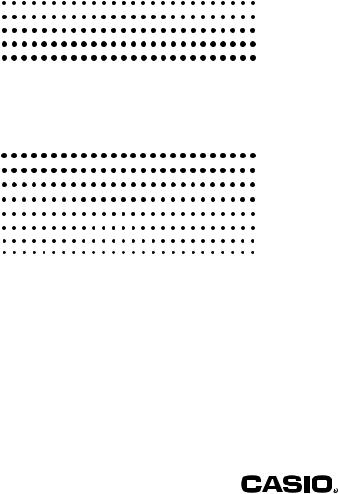
E
fx-50F PLUS
User's Guide
http://world.casio.com/edu/
RCA502903-001V01
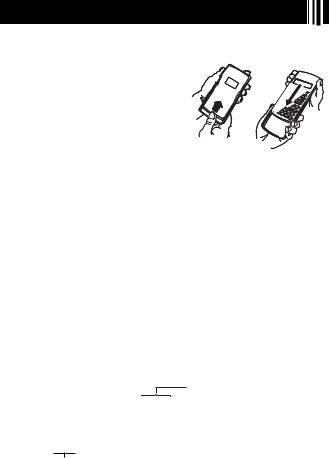



 Getting Started
Getting Started
Thank you for purchasing this CASIO product.
kBefore using the calculator for the first time...
Turn over the calculator and slide it from the hard case as shown in the illustration. Next, slide the hard case onto the back of the calculator.
A After you are finished using the calculator...
Remove the hard case from the back of the calculator, and re-install it onto the front.
kResetting the Calculator to Initial Defaults
Perform the operation below when you want to return the calculator’s setup to its initial defaults. Note that this procedure will also clear all memory contents (independent memory, variable memory, Answer Memory, statistical calculation sample data, and program data).
!9(CLR)3(All)w
Refer to the following for information about the calculation mode and setup and the various types of memories used by this calculator.
• Calculation Modes and Setup (page 7)
Clearing the Calculation Mode and Setup Settings (page 10)
•Calculator Memory Operations (page 19)
•Statistical Calculations (SD/REG) (page 38)
•Program Mode (PRGM) (page 62)
kAbout this Manual
•Most of the keys perform multiple functions. Pressing ! or a and then another key will perform the alternate function of the other key. Alternate functions are marked above the keycap.
Alternate function
|
sin–1{D} |
|
Keycap function |
|
s |
|
||
Alternate function operations are notated in this manual as shown below. Example: !s(sin–1)bw
The notation in parentheses indicates the function executed by the preceding key operation.
E-1
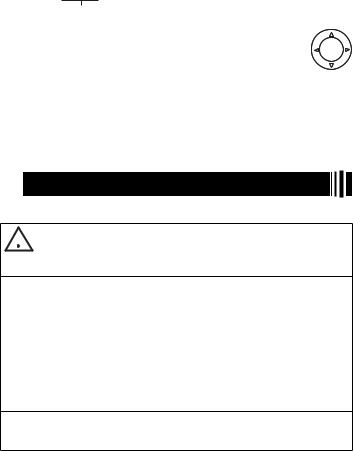
•The following shows the notation used in the manual for menu items that appear on the display (which are executed by pressing a number key).
Example: b(Contrast)
The notation in parentheses indicates the menu item accessed by the preceding number key.
•The cursor key is marked with arrows indicating direction as shown in the illustration nearby. Cursor key operations are notated in this manual as:
REPLAY
f, c, d, and e.
•The displays and illustrations (such as key markings) shown in this User’s Guide are for illustrative purposes only, and may differ somewhat from the actual items they represent.
•The contents of this manual are subject to change without notice.
•In no event shall CASIO Computer Co., Ltd. be liable to anyone for special, collateral, incidental, or consequential damages in connection with or arising out of the purchase or use of this product and items that come with it. Moreover, CASIO Computer Co., Ltd. shall not be liable for any claim of any kind whatsoever by any other party arising out of the use of this product and the items that come with it.



 Safety Precautions
Safety Precautions
Be sure to read the following safety precautions before using this calculator. Keep this manual handy for later reference.
 Caution
Caution
This symbol is used to indicate information that can result in personal injury or material damage if ignored.
Battery
•After removing the battery from the calculator, put it in a safe place where it will not get into the hands of small children and accidentally swallowed.
•Keep batteries out of the reach of small children. If accidentally swallowed, consult with a physician immediately.
•Never charge the battery, try to take the battery apart, or allow the battery to become shorted. Never expose the battery to direct heat or dispose of it by incineration.
•Improperly using a battery can cause it to leak and damage nearby items, and can create the risk of fire and personal injury.
•Always make sure that the battery’s positive k and negative l ends are facing correctly when you load it into the calculator.
•Use only the type of battery specified for this calculator in this manual.
Disposing of the Calculator
•Never dispose of the calculator by burning it. Doing so can cause certain components to suddenly burst, creating the risk of fire and personal injury.
E-2




 Operating Precautions
Operating Precautions
•Be sure to press the O key before using the calculator for the first time.
•Even if the calculator is operating normally, replace the battery at least once every three years.
A dead battery can leak, causing damage to and malfunction of the calculator. Never leave a dead battery in the calculator.
•The battery that comes with this unit discharges slightly during shipment and storage. Because of this, it may require replacement sooner than the normal expected battery life.
•Low battery power can cause memory contents to become corrupted or lost completely. Always keep written records of all important data.
•Avoid use and storage of the calculator in areas subjected to temperature extremes.
Very low temperatures can cause slow display response, total failure of the display, and shortening of battery life. Also avoid leaving the calculator in direct sunlight, near a window, near a heater or anywhere else it might be exposed to very high temperatures. Heat can cause discoloration or deformation of the calculator’s case, and damage to internal circuitry.
•Avoid use and storage of the calculator in areas subjected to large amounts of humidity and dust.
Take care never to leave the calculator where it might be splashed by water or exposed to large amounts of humidity or dust. Such conditions can damage internal circuitry.
•Never drop the calculator or otherwise subject it to strong impact.
•Never twist or bend the calculator.
Avoid carrying the calculator in the pocket of your trousers or other tight-fitting clothing where it might be subjected to twisting or bending.
•Never try to take the calculator apart.
•Never press the keys of the calculator with a ballpoint pen or other pointed object.
•Use a soft, dry cloth to clean the exterior of the calculator.
If the calculator becomes very dirty, wipe it off with a cloth moistened in a weak solution of water and a mild neutral household detergent. Wring out all excess liquid before wiping the calculator. Never use thinner, benzene or other volatile agents to clean the calculator. Doing so can remove printed markings and can damage the case.
E-3




 Contents
Contents
Getting Started ......................................................................................... |
1 |
Before using the calculator for the first time... .................................................................... |
1 |
Resetting the Calculator to Initial Defaults.......................................................................... |
1 |
About this Manual............................................................................................................... |
1 |
Safety Precautions ................................................................................... |
2 |
Operating Precautions ............................................................................. |
3 |
Before starting a calculation... ................................................................ |
6 |
Turning On the Calculator................................................................................................... |
6 |
Key Markings...................................................................................................................... |
6 |
Reading the Display ........................................................................................................... |
7 |
Calculation Modes and Setup ................................................................. |
7 |
Selecting a Calculation Mode............................................................................................. |
7 |
Calculator Setup................................................................................................................. |
8 |
Clearing the Calculation Mode and Setup Settings.......................................................... |
10 |
Inputting Calculation Expressions and Values.................................... |
10 |
Inputting a Calculation Expression (Natural Input) ........................................................... |
10 |
Editing a Calculation......................................................................................................... |
12 |
Finding the Location of an Error ....................................................................................... |
13 |
Basic Calculations.................................................................................. |
14 |
Arithmetic Calculations..................................................................................................... |
14 |
Fractions........................................................................................................................... |
14 |
Percent Calculations......................................................................................................... |
16 |
Degree, Minute, Second (Sexagesimal) Calculations ...................................................... |
17 |
Calculation History and Replay............................................................. |
18 |
Accessing Calculation History ......................................................................................... |
18 |
Using Replay .................................................................................................................... |
19 |
Calculator Memory Operations ............................................................. |
19 |
Using Answer Memory (Ans) ........................................................................................... |
19 |
Using Independent Memory ............................................................................................. |
21 |
Using Variables................................................................................................................. |
22 |
Clearing All Memory Contents ......................................................................................... |
23 |
Using π, e, and Scientific Constants ..................................................... |
23 |
Pi (π) and Natural Logarithm Base e ................................................................................ |
23 |
Scientific Constants.......................................................................................................... |
24 |
Scientific Function Calculations .......................................................... |
26 |
Trigonometric and Inverse Trigonometric Functions ......................................................... |
27 |
Angle Unit Conversion...................................................................................................... |
27 |
Hyperbolic and Inverse Hyperbolic Functions .................................................................. |
28 |
Exponential and Logarithmic Functions ........................................................................... |
28 |
Power Functions and Power Root Functions.................................................................... |
29 |
E-4
Coordinate Conversion (Rectangular ↔ Polar) ................................................................ |
29 |
Other Functions................................................................................................................ |
31 |
Using 103 Engineering Notation (ENG)................................................. |
33 |
ENG Calculation Examples .............................................................................................. |
33 |
Complex Number Calculations (CMPLX) ............................................. |
34 |
Inputting Complex Numbers ............................................................................................. |
34 |
Complex Number Calculation Result Display ................................................................... |
34 |
Calculation Result Display Examples ............................................................................... |
35 |
Conjugate Complex Number (Conjg) ............................................................................... |
36 |
Absolute Value and Argument (Abs, arg) ......................................................................... |
36 |
Overriding the Default Complex Number Display Format................................................. |
37 |
Statistical Calculations (SD/REG) ........................................................ |
38 |
Statistical Calculation Sample Data ................................................................................. |
38 |
Performing Single-variable Statistical Calculations .......................................................... |
38 |
Performing Paired-variable Statistical Calculations .......................................................... |
42 |
Statistical Calculation Examples ...................................................................................... |
50 |
Base-n Calculations (BASE).................................................................. |
52 |
Performing Base-n Calculations ....................................................................................... |
52 |
Converting a Displayed Result to another Number Base ................................................. |
54 |
Using the LOGIC Menu .................................................................................................... |
54 |
Specifying a Number Base for a Particular Value............................................................. |
54 |
Performing Calculations Using Logical Operations and Negative Binary Values ............. |
55 |
Built-in Formulas .................................................................................... |
56 |
Using Built-in Formulas .................................................................................................... |
56 |
Built-in Formula List.......................................................................................................... |
58 |
Program Mode (PRGM) .......................................................................... |
62 |
Program Mode Overview.................................................................................................. |
62 |
Creating a Program .......................................................................................................... |
63 |
Running a Program .......................................................................................................... |
64 |
Deleting a Program........................................................................................................... |
64 |
Inputting Commands ........................................................................................................ |
65 |
Command Reference ....................................................................................................... |
65 |
Appendix ................................................................................................. |
71 |
Calculation Priority Sequence .......................................................................................... |
71 |
Stack Limitations .............................................................................................................. |
72 |
Calculation Ranges, Number of Digits, and Precision...................................................... |
73 |
Error Messages ................................................................................................................ |
74 |
Before assuming malfunction of the calculator... ............................................................. |
76 |
Power Requirements .............................................................................. |
76 |
Specifications ......................................................................................... |
77 |
E-5
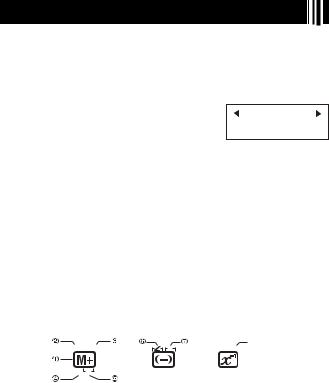



 Before starting a calculation...
Before starting a calculation...
kTurning On the Calculator
Press O. The calculator will enter the calculation mode (page 7) that it was in the last time you turned it off.
A Adjusting Display Contrast
If the figures on the display become hard to read, try adjusting display contrast. |
|
|
1. Press !N(SETUP) db(Contrast). |
L I GHT |
DARK |
• This will display the contrast adjustment screen. |
||
CASIO
2.Use d and e to adjust display contrast.
3.After the setting is the way you want, press A or !p(EXIT).
Note
You can also use + and - to adjust contrast while the calculation mode menu that appears when you press the , key is on the display.
Important!
If adjusting display contrast does not improve display readability, it probably means that battery power is low. Replace the battery.
A Turning Off the Calculator
Press !A(OFF).
The following information is retained when you turn off the calculator.
•Calculation modes and setup (page 7)
•Answer Memory (page 19), independent memory (page 21), and variable memory (page 22) contents
kKey Markings
|
|
|
|
8 |
|
|
M– M |
A |
x! LOGIC |
|
|
DT CL |
|
|
|
|
|
|
|
|
Function |
Colors |
|
To perform the function |
|
|
|
|
|
1 |
M+ |
|
Press the key. |
|
|
|
|
|
|
2 |
M– |
Text: Amber |
Press ! and then press the key. |
|
|
|
|
|
|
3 |
M |
Text: Red |
Press a and then press the key. |
|
|
|
|
|
|
4 |
DT |
Text: Blue |
In the SD or REG Mode, press the key. |
|
5 |
CL |
Text: Amber |
In the SD or REG Mode, press ! and then press |
|
|
|
Frame: Blue |
the key. |
|
|
|
|
|
|
6 |
|
Text: Amber |
In the CMPLX Mode, press ! and then press the |
|
|
|
Frame: Purple |
key. |
|
|
|
|
|
|
E-6
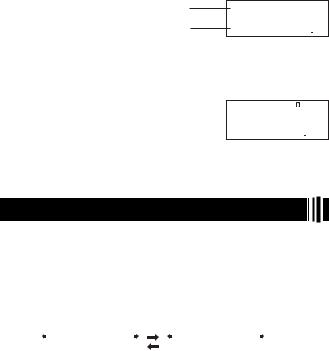
|
Function |
Colors |
To perform the function |
7 |
A |
Text: Red |
Press a and then press the key (variable A). |
|
|
Frame: Green |
In the BASE Mode, press the key. |
|
|
|
|
8 |
LOGIC |
Text: Green |
In the BASE Mode, press the key. |
|
|
|
|
kReading the Display
A Input Expressions and Calculation Results
This calculator can display both the expressions you input and calculation results on the same screen.
Input expression
Calculation result
2× ( 5+ 4 ) – 2× - 3
24
A Display Symbols
The symbols described below appear on the display of the calculator to indicate the current calculation mode, the calculator setup, the progress of calculations, and more. In this manual, the expression “turn on” is used to mean that a symbol appears on the display, and “turn off” means that it disappears.
The nearby sample screen shows the 7 symbol.
s i n ( 30 )
05
The 7 symbol turns on when degrees (Deg) are selected for the default angle unit (page 8). For information about the meaning of each symbol, see the section of this manual that describes each function.



 Calculation Modes and Setup
Calculation Modes and Setup
kSelecting a Calculation Mode
Your calculator has six “calculation modes”.
A Selecting a Calculation Mode
1.Press ,.
•This displays the calculation mode menu.
•The calculation mode menu has two screens. Press , to toggle between them. You can also switch between menu screens using d and e.
COMP CMPLX BASE |
|
SD |
REG |
PRGM |
||
1 |
2 |
3 |
|
4 |
5 |
6 |
E-7
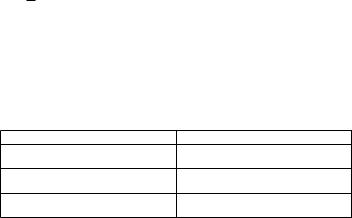
2. Perform one of the following operations to select the calculation mode you want.
To select this calculation mode: |
Press this key: |
|
|
COMP (Computation) |
b(COMP) |
|
|
CMPLX (Complex Number) |
c(CMPLX) |
|
|
BASE (Base n) |
d(BASE) |
|
|
SD (Single Variable Statistics) |
e(SD) |
REG (Paired Variable Statistics) |
f(REG) |
PRGM (Program) |
g(PRGM) |
•Pressing a number key from b to g selects the applicable mode, regardless of which menu screen is currently displayed.
kCalculator Setup
The calculator setup can be used to configure input and output settings, calculation parameters, and other settings. The setup can be configured using setup screens, which you access by pressing !,(SETUP). There are six setup screens, and you can use d and e to navigate between them.
A Specifying the Angle Unit
You can specify degrees, radians, or grads as the angle unit to be applied for trigonometric function calculations.
(90˚ = π radians = 100 grads) 2
Angle Unit |
Perform this key operation: |
Degrees |
!,b(Deg) |
Radians |
!,c(Rad) |
Grads |
!,d(Gra) |
A Specifying the Display Digits
You can select any one of three settings for the calculation result display digits: fixed number of decimal places (0 to 9 places), fixed number of significant digits (1 to 10 digits), or exponential display range (a choice of two settings).
Exponential Display |
Perform this key operation: |
Number of Decimal Places
!,eb(Fix) a(0) to j(9)
Significant Digits
!,ec(Sci) b(1) to j(9), a(10)
Exponential Display Range
!,ed(Norm) b(Norm1) or c(Norm2)
E-8
The following explains how calculation results are displayed in accordance with the setting you specify.
•From zero to nine decimal places are displayed in accordance with the number of decimal places (Fix) you specify. Calculation results are rounded off to the specified number of digits.
Example: 100 ÷ 7 = 14.286 (Fix = 3)
14.29(Fix = 2)
•After you specify the number of significant digits with Sci, calculation results are displayed using the specified number of significant digits and 10 to the applicable power. Calculation results are rounded off to the specified number of digits.
Example: 1 ÷ 7 = 1.4286 × 10–1 |
(Sci = 5) |
1.429 × 10–1 |
(Sci = 4) |
•Selecting Norm1 or Norm2 causes the display to switch to exponential notation whenever the result is within the ranges defined below.
Norm1: 10–2 > x , x > 1010
Norm2: 10–9 > x , x > 1010 |
|
|
Example: 100 ÷ 7 |
= 14.28571429 |
(Norm1 or Norm2) |
1 ÷ 200 |
= 5. × 10–3 |
(Norm1) |
|
0.005 |
(Norm2) |
A Specifying the Fraction Display Format
You can specify either improper fraction or mixed fraction format for display of calculation results.
Fraction Format |
Perform this key operation: |
Mixed Fractions |
!,eeb(ab/c) |
Improper Fractions |
!,eec(d/c) |
A Specifying the Complex Number Display Format
You can specify either rectangular coordinate format or polar coordinate format for complex number calculation results.
Complex Number Format |
Perform this key operation: |
|
|
Rectangular Coordinates |
!,eeeb(a+bi) |
Polar Coordinates |
!,eeec(r Ƨ) |
A Specifying the Statistical Frequency Setting
Use the key operations below to turn statistical frequency on or off during SD Mode and REG Mode calculations.
Frequency Setting |
Perform this key operation: |
|
|
Frequency On |
!,ddb(FreqOn) |
|
|
Frequency Off |
!,ddc(FreqOff) |
|
|
E-9
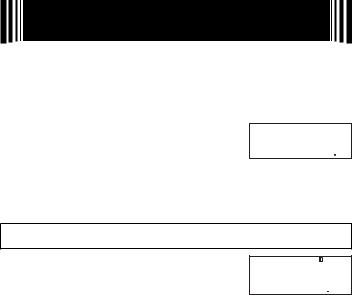
kClearing the Calculation Mode and Setup Settings
Perform the procedure described below to clear the current calculation mode and all setup settings and initialize the calculator to the following.
Calculation Mode ................................ |
COMP (Computation Mode) |
Angle Unit ........................................... |
Deg (Degrees) |
Exponential Display............................. |
Norm1 |
Fraction Format .................................. |
ab/c (Mixed Fractions) |
Complex Number Format ................... |
a+bi (Rectangular Coordinates) |
Frequency Setting .............................. |
FreqOn (Frequency On) |
Perform the following key operation to clear the calculation mode and setup settings.
!9(CLR)2(Setup)w
If you do not want to clear the calculator’s settings, press A in place of w in the above operation.
Inputting Calculation Expressions
and Values
kInputting a Calculation Expression (Natural Input)
The natural input system of your calculator lets you input a calculation expression just as it is written and execute it by pressing w. The calculator determines the proper priority sequence for addition, subtraction, multiplication, division, functions and parentheses automatically.
Example: 2 × (5 + 4) – 2 × (–3) =
2*(5+4)- 2× ( 5+ 4 ) – 2× - 3
2*-3w 24
A Inputting Scientific Functions with Parentheses (sin, cos, ', etc.)
Your calculator supports input of the scientific functions with parentheses shown below. Note that after you input the argument, you need to press ) to close the parentheses.
sin(, cos(, tan(, sin–1(, cos–1(, tan–1(, sinh(, cosh(, tanh(, sinh–1(, cosh–1(, tanh–1(, log(, ln(, e^(, 10^(, '(, 3'(, Abs(, Pol(, Rec(, arg(, Conjg(, Not(, Neg(, Rnd(
Example: sin 30 =
s30)w s i n ( 30 )
05
E-10
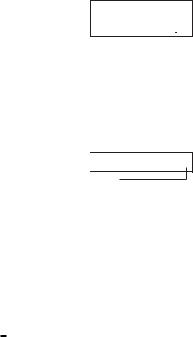
A Omitting the Multiplication Sign
You can omit the multiplication sign in the following cases.
•Immediately before an open parenthesis: 2 × (5 + 4)
•Immediately before a scientific function with parentheses: 2 × sin(30), 2 × '(3)
•Before a prefix symbol (excluding the minus sign): 2 × h123
•Before a variable name, constant, or random number: 20 × A, 2 × π, 2 × i
A Final Closed Parenthesis
You can omit one or more closed parentheses that come at the end of a calculation, immediately before the w key is pressed.
Example: (2 + 3) × (4 – 1) = 15
(2+3)* ( 2+ 3 ) × ( 4– 1
(4-1w 15
•Simply press w without closing the parentheses. The above applies to the closing parentheses at the end of the calculation only. Your calculation will not produce the correct result if you forget the closing parentheses that are required before the end.
A Scrolling the Screen Left and Right
Inputting a mathematical expression that has more than 16 characters in it will cause the screen to scroll automatically, causing part of the expression to move off of the display. The “b” symbol on the left edge of the screen indicates that there is additional data off the left side of the display.
Input Expression |
|
12345 + 12345 + 12345 |
|
Displayed Expression 

 345+ 12345+ 1234 5I
345+ 12345+ 1234 5I
Cursor
•While the b symbol is on the screen, you can use the d key to move the cursor to the left and scroll the screen.
•Scrolling to the left causes part of the expression to run off the right side of the display, which is indicated by the \ symbol on the right. While the \ symbol is on the screen, you can use the e key to move the cursor to the right and scroll the screen.
•You can also press f to jump to the beginning of the expression, or c to jump to the end.
A Number of Input Characters (Bytes)
As you input a mathematical expression, it is stored in memory called an “input area,” which has a capacity of 99 bytes. This means you can input up to 99 bytes for a single mathematical expression.
Normally, the cursor that indicates the current input location on the display is either a flashing vertical bar (|) or horizontal bar ( ). When the remaining capacity of the input area is eight bytes or less, the cursor changes to a flashing box (k).
If this happens, stop input of the current expression at some suitable location and calculate its result.
E-11

kEditing a Calculation
A Insert Mode and Overwrite Mode
The calculator has two input modes. The insert mode inserts your input at the cursor location, shifting anything to the right of the cursor to make room. The overwrite mode replaces the key operation at the cursor location with your input.
|
Original Expression |
Pressing + |
||||||
|
|
|
|
|
|
|
|
|
Insert Mode |
1+2|34 |
1+2+|34 |
|
|||||
|
Cursor |
|
|
|
|
|
|
|
|
|
|
|
|
|
|
|
|
|
|
|
|
|
|
|
|
|
Overwrite Mode |
1+2 3 4 |
1+2 + 4 |
|
|||||
|
Cursor |
|
|
|
|
|
|
|
|
|
|
|
|
|
|
|
|
|
|
|
|
|
|
|
|
|
A vertical cursor (|) indicates the insert mode, while a horizontal cursor ( ) indicates the overwrite mode.
Selecting an Input Mode
The initial default input mode setting is insert mode.
To change to the overwrite mode, press: 1D(INS).
A Editing a Key Operation You Just Input
When the cursor is located at the end of the input, press D to delete the last key operation you performed.
Example: To correct 369 × 13 so it becomes 369 × 12
369*13 369 ×13I
D 369 ×1I
2 369 ×12I
A Deleting a Key Operation
With the insert mode, use d and e to move the cursor to the right of the key operation you want to delete and then press D. With the overwrite mode, move the cursor to the key operation you want to delete and then press D. Each press of D deletes one key operation.
Example: To correct 369 × × 12 so it becomes 369 × 12
Insert Mode
369**12
dd
D
Overwrite Mode
369**12
369××12I
369××I12
369×I12
369×× 12
E-12

ddd
D
369×× 12
369×12
A Editing a Key Operation within an Expression
With the insert mode, use d and e to move the cursor to the right of the key operation you want to edit, press D to delete it, and then perform the correct key operation. With the overwrite mode, move the cursor to the key operation you want to correct and then perform the correct key operation.
Example: To correct cos(60) so it becomes sin(60)
Insert Mode
c60)
dddD
s
Overwrite Mode
c60)
dddd
s
co s ( 60 )I
I60 )
s i n (I60 )
co s ( 60 )
co s ( 60 )
s i n ( 60 )
A Inserting Key Operations into an Expression
Be sure to select the insert mode whenever you want to insert key operations into an expression. Use d and e to move the cursor to the location where you want to insert the key operations, and then perform them.
kFinding the Location of an Error
If your calculation expression is incorrect, an error message will appear on the display when you press w to execute it. After an error message appears, press the d or e key and the cursor will jump to the location in your calculation that caused the error so you can correct it.
Example: When you input 14 ÷ 0 × 2 = instead of 14 ÷ 10 × 2 = (The following examples use the insert mode.)
14/0*2w
e or d
Ma t h ERROR
14÷ 0I×2
Location of Error
E-13
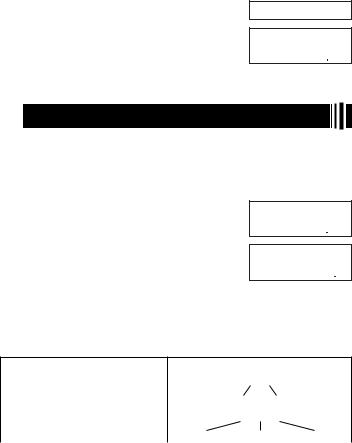
d1
w
14÷ 1I0×2
14 ÷10× 2
28
•Instead of pressing e or d while an error message is displayed to find the location of the error, you could also press A to clear the calculation.



 Basic Calculations
Basic Calculations
Unless otherwise noted, the calculations in this section can be performed in any of the calculator’s calculation mode, except for the BASE Mode.
kArithmetic Calculations
Arithmetic calculations can be used to perform addition (+), subtraction (-), multiplication (*), and division (/).
Example 1: 2.5 + 1 − 2 = 1.5
2.5+1-2w
Example 2: 7 × 8 − 4 × 5 = 36
7*8-4*5w
2 . 5 +1– 2
15
7×8– 4×5
36
•The calculator determines the proper priority sequence for addition, subtraction, multiplication, and division automatically. See “Calculation Priority Sequence” on page 71 for more information.
kFractions
Fractions are input using a special separator symbol ({).
Key Operation |
Display |
Improper |
7 { 3 |
|
7$3 |
||
Fraction |
||
|
Numerator Denominator |
|
Mixed |
2 { 1 { 3 |
|
2$1$3 |
||
Fraction |
||
|
Integer Numerator Denominator |
Note
•Under initial default settings, fractions are displayed as mixed fractions.
•Fraction calculation results are always reduced automatically before being displayed. Executing 2 { 4 = for example, will display the result 1 { 2.
E-14
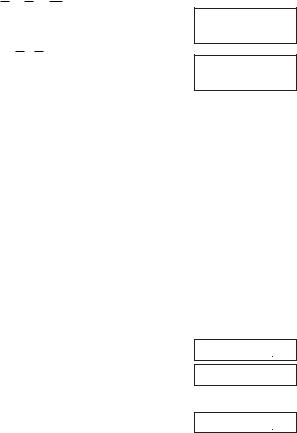
A Fraction Calculation Examples
Example 1: 3 1 + 1 2 = 4 11 4 3 1 2
3$1$4+
1$2$3w
Example 2: 4 – 3 1 = 1
22
4-3$1$2w
3{1{4+1{2{3
4{11{12
4– 3{1{2
1{2
Example 3: |
2 |
+ |
1 |
= |
7 |
(Fraction Display Format: d/c) |
|
3 |
|
2 |
|
6 |
|
2{3+1{2 |
|
|
|
|
|
|
|
2$3+1$2w |
7{6 |
|
|
|
|
|
|
|
|
Note
•If the total number of elements (integer + numerator + denominator + separator symbols) of a fraction calculation result is greater than 10, the result will be displayed in decimal format.
•If an input calculation includes a mixture of fraction and decimal values, the result will be displayed in decimal format.
•You can input integers only for the elements of a fraction. Inputting non-integers will produce a decimal format result.
A Switching between Mixed Fraction and Improper Fraction
Format
To convert a mixed fraction to an improper fraction (or an improper fraction to a mixed fraction), press !$(d/c).
A Switching between Decimal and Fraction Format
Use the procedure below to toggle a displayed calculation result between decimal and fraction format.
Example: 1.5 = 1 |
1 |
, 1 |
1 |
= 1.5 |
2 |
2 |
1.5w |
||
|
|
|
|
|
|
|
|
|
$ |
15
1{1{2
The current fraction display format setting determines if a mixed or improper fraction is displayed.
$ 15
Note
The calculator cannot switch from decimal to fraction format if the total number of fraction elements (integer + numerator + denominator + separator symbols) is greater than 10.
E-15

kPercent Calculations
Inputting a value and with a percent (%) sign makes the value a percent. The percent (%) sign uses the value immediately before it as the argument, which is simply divided by 100 to get the percentage value.
A Percent Calculation Examples
Example 1: |
2 % = 0.02 ( |
2 |
) |
|
|
|
|||||
|
100 |
|
|
2!((%)w |
|
|
|
|
|
|
|
Example 2: |
150 × 20% = 30 |
(150 × |
20 |
) |
|
|
|||||
100
150*20
!((%)w
Example 3: What percent of 880 is 660?
660/880
!((%)w
Example 4: Increase 2,500 by 15%.
2500+2500*
15!((%)w
Example 5: Reduce 3,500 by 25%.
3500-3500*
25!((%)w
Example 6: Reduce the sum of 168, 98, and 734 by 20%.
2%
002
150× 20%
30
660÷880%
75
2500+ 2500× 15%
2875
3500– 3500×25%
2625
168+98+734w
-G*20!((%)w
168+98 + 734
1000
An s –An s ×20%
800
Example 7: If 300 grams are added to a test sample originally weighing 500 grams, what is the percentage increase in weight?
(500+300) ( 500 +300 ) ÷ 500%
/500!((%)w 160
E-16

Example 8: What is the percentage change when a value is increased from 40 to 46? How about to 48?
Insert Mode |
( 46 |
–40 ) ÷40% |
(46-40)/40 |
||
!((%)w |
|
15 |
|
|
eeeeY8w ( 48–40 ) ÷40% 20
kDegree, Minute, Second (Sexagesimal) Calculations
You can perform calculations using sexagesimal values, and you can convert between sexagesimal and decimal.
A Inputting Sexagesimal Values
The following is basic syntax for inputting a sexagesimal value. {Degrees} $ {Minutes} $ {Seconds} $
Example: To input 2°30´30˝
2$30$30$w 2 ˚ 30 ˚ 30 ˚
2˚ 30˚ 30
•Note that you must always input something for the degrees and minutes, even if they are zero.
Example: To input 0°00´30˝, press 0$0$30$.
A Sexagesimal Calculation Examples
The following types of sexagesimal calculations will produce sexagesimal results.
•Addition or subtraction of two sexagesimal values
•Multiplication or division of a sexagesimal value and a decimal value
Example 1: 2°20´30˝ + 39´30˝ = 3°00´00˝
2$20$30$+
0$39$30$w
Example 2: 2°20´00˝ × 3.5 = 8°10´00˝
2 ˚ 20 ˚ 30 ˚ +0 ˚ 39 ˚ 30
3˚ 0˚ 0
2$20$*
3.5w
2 ˚ 20 ˚ ×3. 5
8˚ 10˚ 0
A Converting between Sexagesimal and Decimal
Pressing $ while a calculation result is displayed will toggle the value between sexagesimal and decimal.
E-17
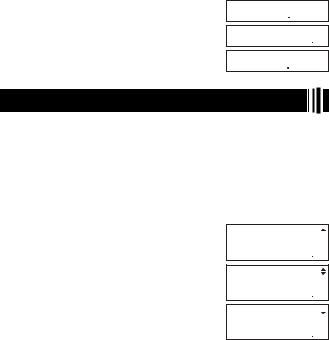
Example: To convert 2.255 to sexagesimal
2.255w
$
$
2255
2˚ 15˚ 18
2255



 Calculation History and Replay
Calculation History and Replay
Calculation history maintains a record of each calculation you perform, including the expressions you input and calculation results. You can use calculation history in the COMP, CMPLX, and BASE Modes.
kAccessing Calculation History
The ` symbol in the upper right corner of the display indicates that there is data stored in calculation history. To view the data in calculation history, press f. Each press of f will scroll upwards (back) one calculation, displaying both the calculation expression and its
result.
Example:
1+1w2+2w
3+3w
f
f
3+ 3
2+2
1+1
6
4
2
While scrolling through calculation history records, the $ symbol will appear on the display, which indicates that there are records below (newer than) the current one. When this symbol is turned on, press c to scroll downwards (forward) through calculation history records.
Important!
•Calculation history records are all cleared whenever you press p, when you change to a different calculation mode, and whenever you perform any reset operation.
•Calculation history capacity is limited. Whenever you perform a new calculation while calculation history is full, the oldest record in calculation history is deleted automatically to make room for the new one.
E-18

kUsing Replay
While a calculation history record is on the display, press d or e to display the cursor and enter the editing mode. Pressing e displays the cursor at the beginning of the calculation expression, while d displays it at the end. After you make the changes you want, press w to execute the calculation.
Example: 4 × 3 + 2.5 = 14.5 4 × 3 – 7.1 = 4.9
4*3+2.5w
d
DDDD
-7.1w
4×3+ 2 . 5
145
4×3+2 . 5I
145
4×3I
145
4×3 –7 . 1
49



 Calculator Memory Operations
Calculator Memory Operations
Your calculator includes the types of memory described below, which you can use for storage and recall of values.
Memory Name |
Description |
|
|
|
|
Answer Memory |
Answer Memory contains the result of the last calculation you |
|
performed. |
||
|
||
Independent |
Independent memory can be used in all calculation modes, except |
|
Memory |
for the SD Mode and the REG Mode. |
|
|
|
|
Variables |
Six variables named A, B, C, D, X, and Y can be used for temporary |
|
storage of values. Variables can be used in all calculation modes. |
||
|
The types of memory described above are not cleared when you press the A key, change to another mode, or turn off the calculator.
kUsing Answer Memory (Ans)
The result of any new calculation you perform on the calculator is stored automatically in Answer Memory (Ans).
E-19

A Ans Update and Delete Timing
When using Ans in a calculation, it is important to keep in mind how and when its contents change. Note the following points.
•The contents of Ans are replaced whenever you perform any of the following operations: calculate a calculation result, add a value to or subtract a value from independent memory, assign a value to a variable or recall the value of a variable, or input statistical data in the SD Mode or REG Mode.
•In the case of a calculation that produces more than one result (like coordinate calculations), the value that appears first on the display is stored in Ans.
•The contents of Ans do not change if the current calculation produces an error.
•When you perform a complex number calculation in the CMPLX Mode, both the real part and the imaginary part of the result are stored in Ans. Note, however, that the imaginary part of the value is cleared if you change to another calculation mode.
A Automatic Insertion of Ans in Consecutive Calculations
If you start a new calculation while the result of a previous calculation is still on the display, the calculator will insert Ans into the applicable location of the new calculation automatically.
Example 1: To divide the result of 3 × 4 by 30 |
3*4w |
3 |
× 4 |
|
|||
|
|
12 |
|
|
|
|
|
An s ÷30 |
|
(Next) /30w |
|
04 |
|
||
|
|
|
Pressing / inputs Ans automatically. |
||
Example 2: To determine the square root of the result of 32 + 42
3x+4xw |
3 2 +4 2 |
|
25 |
||
|
||
|
|
|
9w |
'( Ans |
|
5 |
||
|
Note
•As in the above examples, the calculator automatically inserts Ans as the argument of any calculation operator or scientific function you input while a calculation result is on the display.
•In the case of a function with parenthetical argument (page 10), Ans automatically becomes the argument only in the case that you input the function alone and then press w.
•Basically, Ans is inserted automatically only when the result of the previous calculation is still on the display, immediately after you executed the calculation that produced it. See the next section for information about inserting Ans into a calculation manually with the
K key.
E-20

A Inserting Ans into a Calculation Manually
You can insert Ans into a calculation at the current cursor location by pressing the K key.
Example 1: To use the result of 123 + 456 in another calculation as shown below 123 + 456 = 579 789 – 579 = 210
123+456w 579
789-Kw 789–An s 210
Example 2: To determine the square root of 32 + 42, and then add 5 to the result
3x+4xw 3 2 +4 2
25
9K)+5w '(Ans )+5 10 kUsing Independent Memory
Independent memory (M) is used mainly for calculating cumulative totals.
If you can see the M symbol on the display, it means there is a non-zero value in independent memory.
M symbol
10M+
10
A Adding to Independent Memory
While a value you input or the result of a calculation is on the display, press m to add it to independent memory (M).
Example: To add the result of 105 ÷ 3 to independent memory (M)
105/3m 105÷3M+
35
A Subtracting from Independent Memory
While a value you input or the result of a calculation is on the display, press 1m(M–) to subtract it from independent memory (M).
Example: To subtract the result of 3 × 2 from independent memory (M)
3*21m(M–) 3× 2M–
6
E-21
Note
Pressing m or 1m(M–) while a calculation result is on the display will add it to or subtract it from independent memory.
Important!
The value that appears on the display when you press m or 1m(M–) at the end of a calculation in place of w is the result of the calculation (which is added to or subtracted from independent memory). It is not the current contents of independent memory.
A Viewing Independent Memory Contents
Press tm(M).
A Clearing Independent Memory Contents (to 0)
01t(STO)m(M)
Clearing independent memory will cause the M symbol to turn off.
A Calculation Example Using Independent Memory
If the M symbol is displayed on your calculator screen, press 01t(STO)m(M) to clear independent memory contents before performing the following operation.
Example: |
23 |
+ 9 |
= 32 |
23+9m |
|||
|
|
53 |
– 6 |
= 47 |
53-6m |
||
−) |
45 |
× 2 |
= 90 |
45*21m(M–) |
|||
|
|
99 |
÷ 3 |
= 33 |
99/3m |
||
|
|
|
|
|
|
||
|
|
(Total) 22 |
tm(M) |
||||
|
|
|
|
|
|
|
|
|
|
|
|
|
|
|
|
(Recalls value of M.)
kUsing Variables
The calculator supports six variables named A, B, C, D, X, and Y, which you can use to store values as required.
A Assigning a Value or Calculation Result to a Variable
Use the procedure shown below to assign a value or a calculation expression to a variable.
Example: To assign 3 + 5 to variable A 3+51t(STO)-(A)
A Viewing the Value Assigned to a Variable
To view the value assigned to a variable, press t and then specify the variable name.
Example: To view the value assigned to variable A t-(A)
A Using a Variable in a Calculation
You can use variables in calculations the same way you use values.
Example: To calculate 5 + A
5+a-(A)w
E-22

A Clearing the Value Assigned to a Variable (to 0)
Example: To clear variable A 01t(STO)-(A)
A Calculation Example Using Variables
Example: To perform calculations that assign results to variables B and C, and then use the variables to perform another calculation
9 × 6 + 3 |
= 1.425 |
|
|
5 × 8 |
9×6+3→B |
||
9*6+3 |
|||
|
|||
|
1t(STO)$(B) |
57 |
|
|
|
||
|
|
|
|
|
5*8 |
5×8→C |
|
|
1t(STO)w(C) |
40 |
|
|
|
||
|
|
|
|
|
|
||
|
S$(B)/ |
B÷C |
|
|
Sw(C)w |
1425 |
|
|
|
|
|
kClearing All Memory Contents
Perform the following key operation when you want to clear the contents of independent memory, variable memory, and Answer Memory.
19(CLR)1(Mem)w
•If you do not want to clear the calculator’s settings, press A in place of w in the above operation.
Using π, e, and Scientific
Constants
kPi (π) and Natural Logarithm Base e
The calculator supports input of pi (π) and natural logarithm base e into calculations. π and e are supported in all modes, except for the BASE Mode. The following are the values that the calculator applies for each of the built-in constants.
π = 3.14159265358980 (1e(π)) e = 2.71828182845904 (Si(e))
E-23
